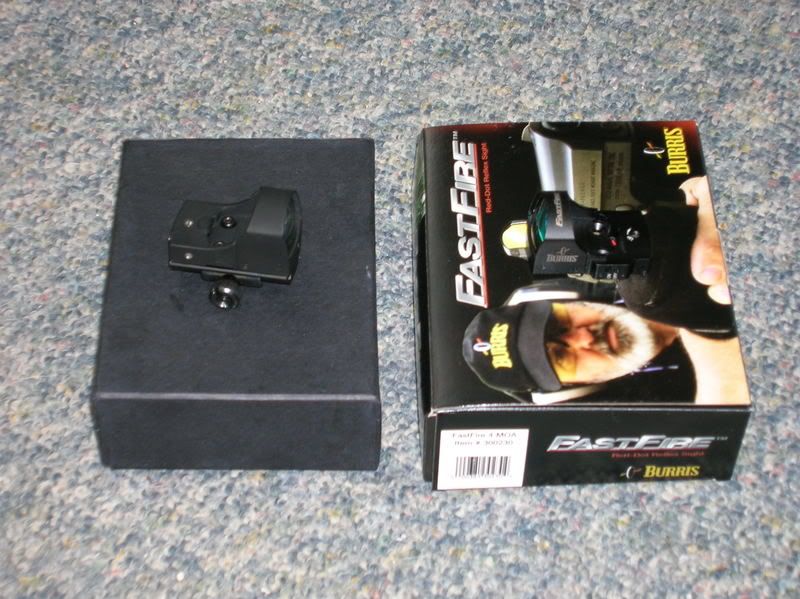

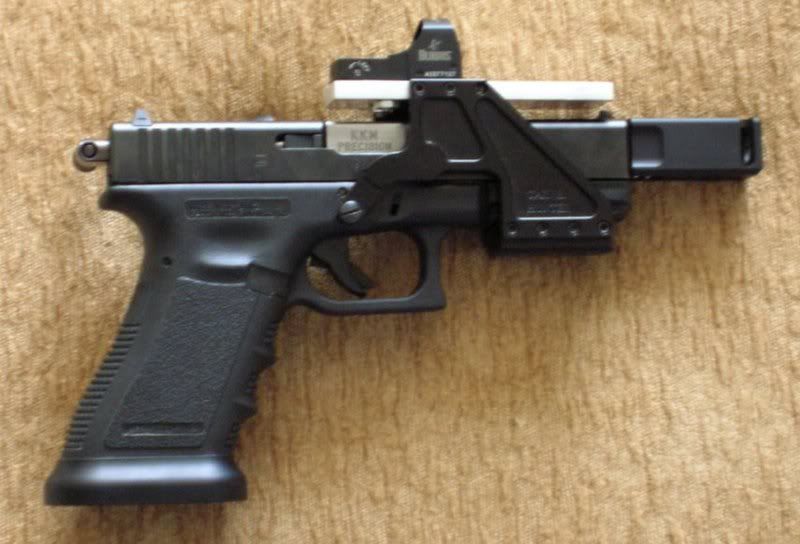
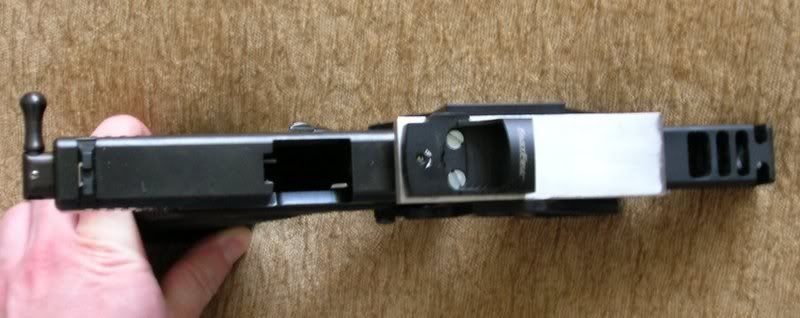 I got the Lone Wolf red dot sight (catalog number: LWD-RDS) first. Testing it out, I quickly discovered that it was really hard to find the dot when aiming at a light colored targets that was brightly lit. The dot also flares pretty bad in twilight.
I got the Lone Wolf red dot sight (catalog number: LWD-RDS) first. Testing it out, I quickly discovered that it was really hard to find the dot when aiming at a light colored targets that was brightly lit. The dot also flares pretty bad in twilight.I read a few short reviews on the Burris FastFire red dot, a similar micro reflex sight. As I write this, the sights are hard to come by, and feedback on them is pretty hard to find, although most of what I found was positive. Finding that Natchez had them available, I placed an order for a FastFire, a Glock slide mount for the sight, and while I was at it, ordered a few $15 Glock factory magazines.
The two sights are very similar, and both share more than a little in common with the Docter Optic sights, now imported by Trijicon. There are reports on the internet that the FastFire works on Docter mounts and vice versa, although the screw threads are different. I tried the FastFire on the Lone Wolf base, and vice versa. Again, except for different screw threads, the sights are interchangeable. The JPoint is a different animal, and the screw holes are in a different location altogether.
Construction wise, the sights are pretty much the same. The main body of the sights seem to be cast aluminum with the hood being a piece of aluminum sheet. The lens, or window, or whatever you want to call it is glass on both, not plastic like in the JPoints. The FastFire has a magnet that holds the battery in place, which is handy and lacking on the Lone Wolf sight. The adjustment bar, for lack of a better term, on the Lone Wolf sight appears to be a more roughly cast part than on the Burris sight, which seems to have a machined adjustment bar. The electronic bits of the FastFire are more securely glued in place than in the Lone Wolf sight. I’m not saying that anything is floating around loose in the Lone Wolf sight, only that the Fast Fire might be more recoil resistant.
Sitting the Lone Wolf and FastFire side-by-side, the FastFire is noticeably brighter, which is what I was after. The FastFire dot still flares a bit in low light, but being brighter, the dot is much easier to find. Although the Lone Wolf sight is advertised to have a 6MOA dot, it appears to be exactly the same size as the FastFire 4MOA dot.
For my purposes, the FastFire is the better product. To be fair to Lone Wolf, Burris only offers a one-year limited warranty, and the Burris sight costs twice as much. The Lone Wolf sight works pretty damn well indoors, but would not work as well for sunny outdoor or low-light matches. Although I could have used the Lone Wolf RDS on one of several plinkers, or put it on the airsoft Glock to train with, ultimately I needed the $80 back more.
For the price of an unmodified Docter Optic mini-reflex sight, you could buy 5 or 6 Lone Wolf red dot sights. For the price of a (plastic) JPoint, you could buy 3 of the metal and glass Lone Wolf sights. Neither of the more expensive sights is particularly bright either, except for the Docters modified by Beven Grams of Grams Engineering, and the modification costs another 1.5 times the price of the Lone Wolf.
Pictures of the FastFire mounted on a Glock are of my racegun, as it currently stands. It is a Glock 17 with a Carver Hunter mount and a top plate that I cut from 1/4" thick aluminum. The whole point of fiddling with the slide-ride optic was to get a red dot scope small enough that I could mount it forward of the ejection port where it wouldn't interfere with ejection and get beaten up by the reciprocating slide.
Live Fire Testing
I had a little trouble sighting it in at first. A couple times I forgot to unlock the adjustments, which put me way off in the wrong direction. Once I figured out what I was doing wrong, it wasn't long before I was shooting out the X-Ring at 50 feet.
For a while, I had trouble finding the dot, and had put a pin at the front of the mounting plate, which I used to help find the dot. After a little practice with the new set-up, I found that I wasn't using the pin anymore, and have since removed it. I will cut the mounting plate down to match the front of the scope mount eventually.
The adjusting wheel that fits over the shaft of the screwdriver makes it pretty much impossible to see where you're putting the blade. I'm thinking about drilling a few holes in the wheel, but I'm a little concerned that I'll then end up breaking the plastic wheel in my gear bag.
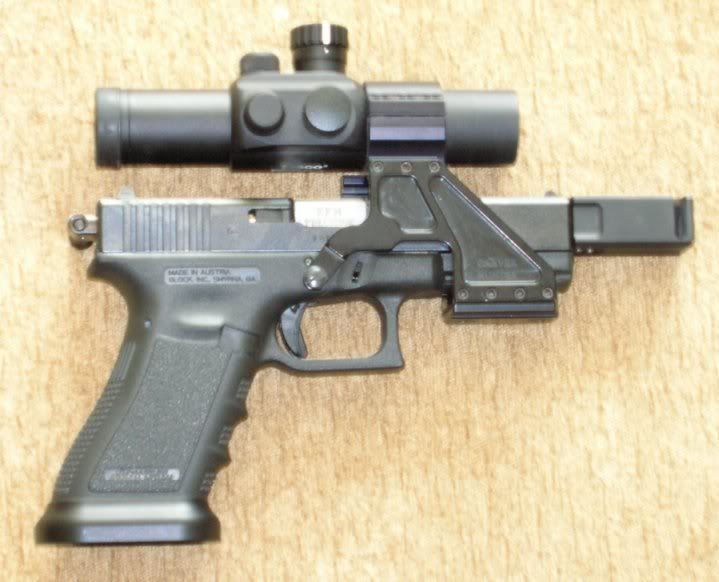 My RaceGun with the PDP2 before I got the FastFire set-up
My RaceGun with the PDP2 before I got the FastFire set-upUPDATE: I've noticed the dot getting really dim now and then. After firing a shot it gets back to full brightness. After the last outdoor match of the season, I'll call Burris and see if there's a fix.
UPDATE, AGAIN: Got to poking around on the internet, and discovered that others were having the same problems with the dot fading out randomly, and then coming back after firing a shot. Putting a piece of rubber band between the mount and battery seems to be a half-assed, although effective solution.
UPDATE, AGAIN: Got to poking around on the internet, and discovered that others were having the same problems with the dot fading out randomly, and then coming back after firing a shot. Putting a piece of rubber band between the mount and battery seems to be a half-assed, although effective solution.
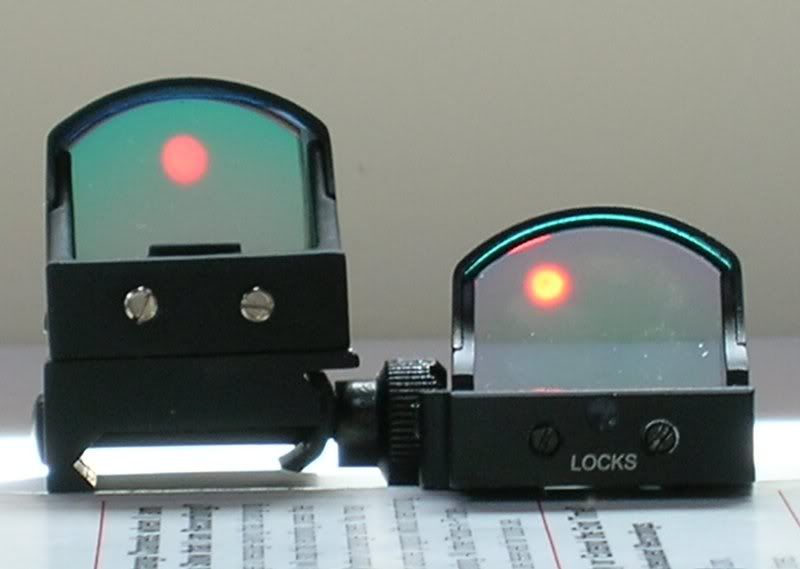

No comments:
Post a Comment